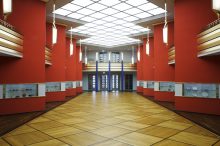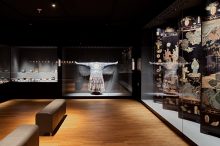GRASSI Museum of Applied Arts, Germany
 Grassi Museum, an impressive building complex in Art-Deco style, houses three museums of domestic and international significance: the Museum of Applied Arts, the Museum of Ethnology (also an ASEMUS member), and the Museum of Music Instruments. At the center of attraction in the three museums are their respective new feature of permanent exhibitions and alternating special exhibitions.
The centerpiece of Grassi Museum is the Art Deco column hall. The central exhibition and event hall designed in shining red-gold-blue remains unparalleled all over Europe. The column hall that is named after its twelve ceiling-high triangular columns, represents the exclusive designing style of Art Deco.
Grassi Museum is seen as a place of culture and inspiration. Its vegetated inner courtyards, the old Johannis cemetery, which looks like a park and the highly inviting Museum Café set the scene perfectly well for enjoying leisure times.
Today, the GRASSI Museum of Applied Arts counts among the most significant of its type in Europe and stands out for a completely new permanent exhibition. The first exhibition area, entitled “From Antiquity to Historism”, is a call to a journey covering over 3,000 years of the history of art. Amongst others, the fascination in this journey is the Roman Hall, the Piranesi Gallery and precious Baroque items of the Treasure Chamber. The second exhibition area, “Asian art: Impulse for Europe”, is, above all else, dedicated to art treasures from China, Japan and Iran. In the third area, “From Art Nouveau to the Present Day”, there is a series of treasures from the period of Art Nouveau of known and unknown Bauhaus pieces, design highlights as from 1950, East German design
Grassi Museum, an impressive building complex in Art-Deco style, houses three museums of domestic and international significance: the Museum of Applied Arts, the Museum of Ethnology (also an ASEMUS member), and the Museum of Music Instruments. At the center of attraction in the three museums are their respective new feature of permanent exhibitions and alternating special exhibitions.
The centerpiece of Grassi Museum is the Art Deco column hall. The central exhibition and event hall designed in shining red-gold-blue remains unparalleled all over Europe. The column hall that is named after its twelve ceiling-high triangular columns, represents the exclusive designing style of Art Deco.
Grassi Museum is seen as a place of culture and inspiration. Its vegetated inner courtyards, the old Johannis cemetery, which looks like a park and the highly inviting Museum Café set the scene perfectly well for enjoying leisure times.
Today, the GRASSI Museum of Applied Arts counts among the most significant of its type in Europe and stands out for a completely new permanent exhibition. The first exhibition area, entitled “From Antiquity to Historism”, is a call to a journey covering over 3,000 years of the history of art. Amongst others, the fascination in this journey is the Roman Hall, the Piranesi Gallery and precious Baroque items of the Treasure Chamber. The second exhibition area, “Asian art: Impulse for Europe”, is, above all else, dedicated to art treasures from China, Japan and Iran. In the third area, “From Art Nouveau to the Present Day”, there is a series of treasures from the period of Art Nouveau of known and unknown Bauhaus pieces, design highlights as from 1950, East German design  and pieces from the immediate present.
Moreover, the special exhibitions and the GRASSI TRADE FAIR that is held each year at the end of October – one of Europe’s most significant sales expositions for applied arts and design – are also a centerpiece of public attention.
and pieces from the immediate present.
Moreover, the special exhibitions and the GRASSI TRADE FAIR that is held each year at the end of October – one of Europe’s most significant sales expositions for applied arts and design – are also a centerpiece of public attention.
Historical background
Upon the death of the Tradesman and Patron from Leipzig Franz Dominic Grassi (1801 – 1880), the city of Leipzig inherited a considerable asset. Amongst others, it was invested in the construction of the new Gewandhaus, the Mende fountain and in the “old” Grassi museum at the former King’s square, today’s City Library at Leuschner square. Since the capacity of the building soon became too small, it was sold and the proceeds invested in the construction of today’s Grassi museum at Johannis square. The building complex that was erected here from 1925 to 1929 belongs to one of the few new museum buildings of the 1920s in Germany. Following the massive destruction of the building in the course of the Second World War, post-war reconstruction was only gradual and provisional. The Grassi Museum was fundamentally refurbished in the years 2001 to 2005, and has been shining ever since in new splendor. The museums are able to present their collections effectively for the first time since the end of the war.Permanent collections
The Grassi Museum of Applied Arts has approximately more than 90,000 items. Abundantly available in stock are the classical material areas of textile, ceramics, porcelain, furniture, glass, noble and base metals from ancient times to the present day; plastics made of wood and stone; coins, medals, badges; Asian and a range of other special collections. Furthermore, the graphic collection covers approximately 50,000 sheets, and the photo collection approximately 70,000 units.
"From Antiquity to Historism"
The first exhibition features the older sections of the collection. It has been designed as a cross-genre presentation with an emphasis on art and cultural history whose essential structure is to remain for a longer period of time.
Among the highlights of this part of the exhibition, which covers approx. 2000 m², are a walk-in display cabinet with Italian Renaissance maiolica and three historic rooms. While the panelling from the monastery refectory in Cori near Rome is unique in a museum context, the chinoiserie wall covering from the manor house in Zehmen near Leipzig, which is presented to the public for the first time, is full of exotic beauty. But also the Roman Hall from the mansion of Eythra – one of the villages that were forced to give way to brown coal mining in the Leipzig area – has been resurrected after many years of restoration.
References to the history of Saxony and Leipzig are of particular importance in all three parts of the exhibitions. Among many other items, the first part, for instance, presents works of art from Leipzig’s council treasure and from the cabinet of art and rarities that was annexed to the old council library. Furniture from the foremost workshops of Leipzig, ceramics, porcelain, glasses, gold and silversmiths’ work bear witness to the mastery of Saxon artists and craftspeople.
"Asian Art – Impulses for Europe"
Numerous exhibits that had been inaccessible for decades are shown in this part of the exhibition. The permanent exhibition shows pieces from China, Japan, Korea as well as Iran, Turkey and India. The collection size is around 6000 objects.
The exhibition area covers around 300 m². Located on the gallery floor and in two adjacent rooms, it serves as a link between the other permanent exhibitions of the museum.
"From Art Nouveau to the Present Day"
Selected holdings of the collection ranging from art nouveau to present-day items are shown on the upper floor. Here, particular emphasis is laid on works from the 1920s and 1930s. Purchased, for the most part, at the then legendary Grassi Fairs , these items present a unique historical testimony. A special touch will be added by the reconstruction of the fair booth of the Vereinigte Lausitzer Glaswerke (United Lusatian Glassworks) of Weißwasser, designed by Lilli Reich for the Grassi Fair in 1936.
On the ground floor, the exhibition of the Grassi Museum of Applied Arts continues with objects from the second half of the 20th century to the present-day. In contrast to the other parts of the permanent exhibition, the quantity of items here necessitates a more flexible presentation.
View all Asia-Europe Museum Network (ASEMUS) members in Germany
Similar content
07 Dec 2017
posted on
03 Mar 2012
from - to
17 Feb 2012 - 27 May 2012
posted on
25 Mar 2012
02 Apr 2015
